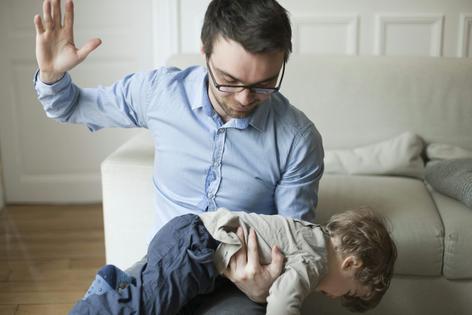As views on spanking shift worldwide, most US adults support it, and 19 states allow physical punishment in schools
Published in Health & Fitness
_Nearly a half-century after the Supreme Court ruled that school spankings are permissible and not “cruel and unusual punishment”, many U.S. states allow physical punishment for students who have misbehaved.
_Today, over a third of the states allow teachers to paddle or spank students. More than 100,000 students are paddled in U.S. schools each year.
Christina Erickson, an associate dean and professor of social work at the University of North Dakota, wrote a book on the subject: “Spanked: How Hitting Our Children is Harming Ourselves.” She discussed the scope of the practice and its effects with The Conversation.
Around the world, 68 countries have banned the hitting of children in any form, including spanking. This movement began in 1979 with Sweden’s ban on all forms of physical punishment, including spanking in any setting, and including in the family home.
The pace of change quickened in the early 2000s when more countries adopted similar laws. For example, the legal language of countries like Nepal rests on an emerging definition of children as rights holders similar to adults and as humans worth protecting from harm.
Each state in the U.S. has its own child abuse laws, and all states, tribes and territories aim to protect children from abuse. But all state laws also allow parents to hit their children if it does not leave an injury or a mark.
A typical example is Oklahoma’s definition of child abuse and neglect. It includes an exception that permits parents to use ordinary force as a means of discipline, including spanking, using an implement like a switch or a paddle. However, leaving evidence of hitting, such as welts, bruises, swelling or lacerations, is illegal and considered child abuse in all states.
Parental spanking of children is considered unique from other physical violence because of the relational context and the purpose. Laws entitle parents to hit their children for the purpose of teaching a lesson or punishing them to improve behavior. Children are the only individuals in society who can be hit by another person and the law does not regard it as assault.
Spanking’s impact on a child is unfortunately similar to abusive hitting. Spanking has been labeled as an “Adverse Childhood Experience,” or ACE. These are events that cause poor health outcomes over the span of one’s life.
The practice of spanking also affects parents. Acceptance of the physical discipline of spanking puts parents at risk for the escalation of physical punishment that leads to abuse.
Parents who spank their child have the potential to abuse them and be caught in a legal and child protection system that aims to protect children from harm. It is unclear what triggers a parent to cross over from discipline into abuse. Research shows that spanking at a young age, such as a 1-year-old, increases the chance of involvement by Child Protective Services by 33%.
Some school districts require permission from parents to allow disciplinary paddling in school, while others do not require any communication. State law does not assure agreement between parents and school districts on what offenses warrant a paddling. Parents may feel they have no alternative but to keep their child in school, or fear reprisal from school administrators. Some students are old enough to denounce the punishment themselves.
The term spank conceals the concept of hitting and is so commonplace it goes unquestioned, despite the fact that it is a grown adult hitting a person much smaller than them. The concept is further concealed because hitting a child’s bottom hides any injuries that may occur.
Types of hitting that are categorized as spanking have narrowed over the years but still persist. Some parents still use implements such as tree switches, wooden spoons, shoes or paddles to “spank” children, raising the chances for abuse.
Most spanking ends by the age of 12, partly because children this age are able to fight back. When a child turns 18, parental hitting becomes the same as hitting any other adult, a form of domestic violence or assault throughout the U.S.
There is a lack of a consistent understanding of what constitutes a spanking. The definition of spanking is unique to each family. The number of hits, clothed or not, or using an implement, all reflect geographical or familial differences in understanding what a spanking is.
People in the United States generally accept spanking as part of raising children: 56% of U.S. adults strongly agree or agree that “… it is sometimes necessary to discipline a child with a good, hard spanking.” This view has been slowly changing since 1986, when 83% of adults agreed with that statement.
The laws worldwide that protect children from being hit usually begin by disallowing nonparental adults to hit children. This is happening in the U.S. too, where 31 states have banned paddling in schools.
At a national level, efforts have been made to end physical punishment in schools. However, 19 states still allow spanking of children in public schools, which was upheld by a 1977 Supreme Court case.
With the slow but steady drop of parents who believe that sometimes children need a good hard spanking, as well as the ban of paddling in schools in 31 states, one could argue that the U.S. is moving toward a reduction in spanking.
Spanking’s negative influence on children’s behavior has been documented for decades. Spanking seems to work in the moment when it comes to changing or stopping the immediate behavior, but the negative effects are hidden in the short term and occur later in the child’s life. Yet because the spanking seemed to work at the time, the parent doesn’t connect the continued bad behavior of the child to the spanking.
An abundance of research shows that spanking causes increased negative behaviors in childhood. Spanking lowers executive functioning for children, increases dating violence as teenagers and even increases struggles with mental health and substance abuse in adulthood. Spanking does not teach new or healthy behaviors, and is a stress-inducing event for the child and the adult hitting them.
No studies have shown positive long-term benefits from spanking. Because of the long-standing and expansive research findings showing a range of harm from spanking and the increased association with child abuse, the American Psychological Association recommends that parents should never spank their children.
Consider these questions when choosing a discipline method for your child:
Is the expectation of your child developmentally accurate? One of the most common reasons parents spank is because they are expecting a behavior the child is not developmentally able to execute.
Can the discipline you choose grow with your child? Nearly all spanking ends by age 12, when kids are big enough to fight back. Choose discipline methods you can use over the long term, such as additional chores, apologies, difficult conversations and others that can grow with your child.
Might there be another explanation for your child’s behavior? Difficulty of understanding, fear or miscommunication? Think of your child as a learner and use a growth mindset to help your child learn from their life experiences.
Parents are the leaders of their families. Good leaders show strength in nonthreatening ways, listen to others and explain their decisions. Don’t spoil your kids. But being firm does not have to include hitting.
Doubtful. Parents who hit their kids may be unaware that it influences their frustration in other relationships. Expressing aggression recharges an angry and short-tempered internal battery that transfers into other parts of the adults’ lives.
Practicing calm when with your children will help you be calmer at work and in your other relationships. Listening to and speaking with a child about challenges, even from a very early age, is the best way to make it part of your relationship for the rest of your life.
Choose a method that allows you to grow. Parents matter too.
This article is republished from The Conversation, a nonprofit, independent news organization bringing you facts and trustworthy analysis to help you make sense of our complex world. It was written by: Christina Erickson, University of North Dakota
Read more:
Hard evidence: spanking could lead to health problems, antisocial behavior
Is it OK to spank a misbehaving child once in a while?
School spankings are banned just about everywhere around the world except in US
Christina Erickson does not work for, consult, own shares in or receive funding from any company or organization that would benefit from this article, and has disclosed no relevant affiliations beyond their academic appointment.














Comments